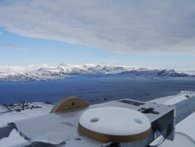ASIRIS
A GNSS station with a reflectometry receiver was set up at Kongsfjorden (Spitsbergen), 78°54’14’’N, 11°52’37’’E, 512m above ellipsoid (WGS-84). This permanent station is operated by GFZ in collaboration with NPI (Norwegian Polar Institute) at the Zeppelin mountain outpost. It accumulates a data set since summer 2013 observing reflections over the fjord and the adjacent land surface. Especially the changing surface types: the fjord, adjacent glaciers and the variable snow-cover over land are of interest to investigate GNSS reflectometry applications.
The setup contains a GORS (GNSS Occultation Reflectometry Scatterometry) four-frontend receiver, which is based on commercial JAVAD hardware. The receiver is connected to an uplooking antenna and a further antenna tilted towards the horizon. The tilted antenna has two polarization links (right-handed and left-handed). The antenna mount is installed approximately 476m above mean sea level with an extensive view over Kongsfjorden, see Fig. 1.
Reflections are observed at low elevation angles of the transmitter (between 10° and 2°). They appear over the fjord and adjacent land areas. Within a master thesis the signal-to-noise ratio (SNR) was examined for more than 50 daily recurring reflection events. Significant differences in reflection signatures arise from the surface type (fjord or land) [1]. A difficulty occurs due to the drift of GNSS satellite orbits in case of the long-range observations. Although recurring, reflection points are shifted in time, e.g., > 100 m for a range of 10 km.
A topography adapted reflection model, which considers sloped surface facets, has been developed and presented [2]. It incorporates a digital elevation model, provided by NPI. The differential Doppler shift (reflected to direct signal) is computed for each facet, see Fig. 2.
The model allows to geolocate observed signatures that are plotted for the given data set in elevation-Doppler maps [3]. Perspectively land surface topography can be inverted from Doppler retrievals of the reflection events.
References
[1] Semmling, M.; Peraza, L.; Falck, C.; Gerland, S. & Wickert, J.: Doppler shift estimation for GNSS reflectometry using a land topography adapted reflection model. Geophysical Research Abstracts, EGU General Assembly, 2016, Vol. 18, EGU2016-17139
[2] Peraza, L.: Signal Power Analysis of GNSS Reflections recorded at Kongsfjorden, Spitsbergen. Technical University Berlin, 2016
[3] Peraza, L.; Semmling, M.; Wickert, J.; Pavlova, O.; Gerland, S.; Falck, C.: Analysis of grazing GNSS reflections observed at the Zeppelin mountain station, Spitsbergen. Radio Science, 2017





